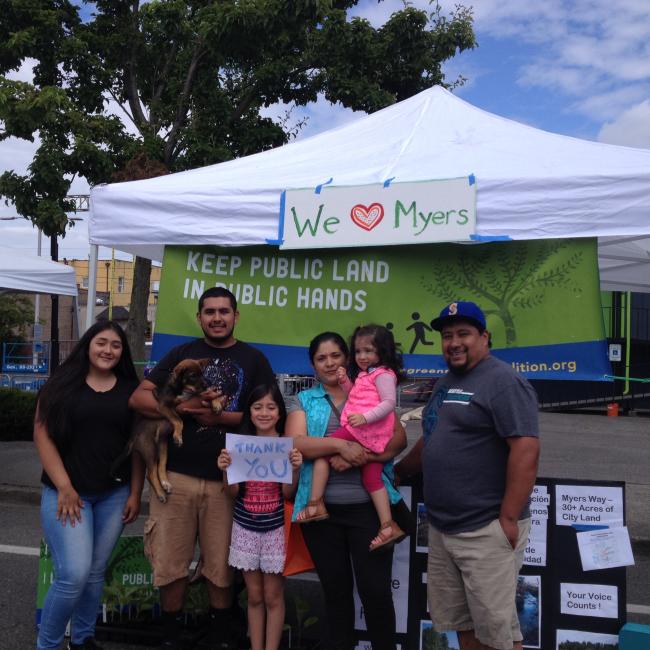At Large In Ballard: Timber
The Salas family said thank you to Mayor Murray last July for not selling Myers Way.
Mon, 01/02/2017
By Peggy Sturdivant
I hate a late Friday surprise. That’s why I don’t always read Friday’s “Office of the Mayor” email if I’ve had a long week. I don’t recall when I read the Mayor’s December 9, 2016 missive, but I distinctly remembering screaming.
What I consider a bombshell was masquerading as a headline: “City uses surplus property to support affordable housing.”
No. No. No. The Mayor of Seattle cannot just decide to sell surplus property. Or does Mayor Murray’s claim of a creative way to finance affordable housing render the guidelines null and void?
The surprise isn’t that the City of Seattle has property that no longer is needed by various departments for its original purpose. The shocker is that with a paragraph in his weekly newsletter Mayor Ed Murray changed the definition of “surplus property” to “available for sale.”
Frankly there’s no land owned by the City that should be considered excess or surplus. We’re out of land. As my colleague Mary Fleck of Seattle Green Spaces Coalition counters with regard to any of the city’s holdings, “that property isn’t surplus to the people.”
I’ve been tracking public land in Seattle for at least 20 years, dating back to the founding of Groundswell NW to convert a parking lot into a park. We know that it’s a private owner’s prerogative to sell their property and a developer’s bottom line to have it rezoned to accommodate multiple units. But I don’t think the city should be able potentially stick ‘For Sale’ signs on its properties and claim “creative and bold solutions” for homelessness.
Historically the potential sale of city property has at the least called for a review process, with its sale as the last option. Finance and Administrative Services (FAS) is in charge of managing city property that has been declared excess, which City Council can then declare surplus after each Department has reviewed it for possible use. The flow chart includes public engagement and assessment of many potential uses, like those identified by the neighborhood plans or meeting the Parks Department’s open space goals.
Citing a recommendation from the Housing Affordability and Living Agenda (HALA), Murray seems to flip the process over completely, taking out public engagement and the review process, and going straight to: “For Sale.” The action is based on a false assumption, that any city property is surplus. The newly passed Comprehensive Plan 2035 includes other ideas for surplus property, like using it for arts and cultural institutions, for local food production, or for parks and green space.
Mayor Murray’s office says, “the HALA committee saw an opportunity to leverage these increasingly valuable resources in this current market to support the construction of more affordable homes.”
Translation: the HALA committee sees an opportunity to sell publicly owned property for profit, bypassing established public process and even though HALA is establishing other ways to fund affordable housing.
Last February I overdramatically threw myself around a cherry tree on a surplus Seattle City Light substation before it could blossom one last time. The act didn’t stop the chain saws. Last spring I was part of an effort with Seattle Green Spaces Coalition to keep Myers Parcels, the last 33 acres of publicly-owned open space from being sold, supposedly to fight homelessness with a one-time land sale. On July 13, 2016, after the public had learned and protested the potential sale, Mayor Murray agreed not to sell that land. So imagine my surprise reading the December 9th message. “City uses surplus property to support affordable housing.” Not even, ‘City considers using public property…’ And I keep wondering why no one outside of Seattle Green Spaces Coalition seems to have noticed.
Then again not everyone gets the weekly newsletter and I’m not sure who is tracking on press releases.
I do know this city is starved for space, yes for affordable housing, but also for greenways and buffers, open space. Just because the city owns land that its departments are not using doesn’t mean we should sell the land without a coherent and comprehensive approach.
In West Seattle a woman who grew up here has a dream to create the Urban Homestead farm school on a piece of surplus property right across from the brand new Schmitz Park Elementary School. Also in West Seattle another piece of surplus property has become an environmental learning center for local students who are learning how to steward wetland and identify plants.
The land is surplus by definition only. It’s desperately needed for its role in meeting Seattle’s Climate Action Plan and Tree Canopy goals (even though they keep getting lowered). Each property’s greatest value is in being repurposed for public use, not sold to supposedly fund “affordable housing.” Some of the properties might be great locations for the city to actually site affordable housing, but through a partnership, not a blanket sale to a private developer.
I can see the irony in spending most of my year working on a project in Ballard called “Shingletown to Tomorrow” and now trying to stop more trees being cut, more open space filled. We’ve cut enough forest in Seattle and now we need to save and restore what’s left of the green. In the case of Murray’s headline, let’s keep it from becoming mine.
For a map of city-owned land see www.seattlegreenspacescoalition.org


